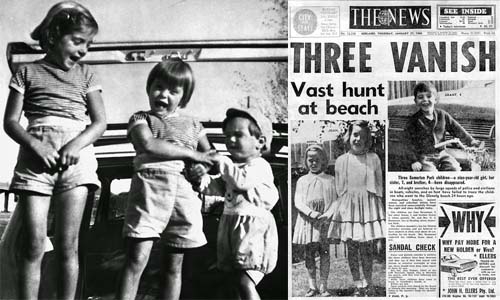The child abduction case that changed Australia forever
The postman saw three seemingly happy children, ages 9, 7 and 4, walking home from the beach. The kids were holding hands, giving the onlooker no reason to worry. But his was the last reported sighting of the Beaumont children, whose case would forever change the way Australian parents thought about letting their kids go out alone.
In photos of them playing on the beach and riding bicycles, Jane, Arnna and Grant look content, safe and sun-kissed — the image of a wholesome midcentury childhood. But Australia Day 1966, the date they disappeared, is the moment to which many trace a loss of innocence Down Under, a specific event that stopped parents thinking it was safe to let children out alone. The day every stranger became a potential abductor. “The case has tapped into so many deep issues about what being safe as a child means,” says Beth Spencer, who’s written extensively about the Beaumonts, “and the idea that it is possible for children to ‘disappear’ or become ‘lost’ … even in the midst of a normal suburb or a crowded beach
Parents began driving kids to school, not letting them leave the house unsupervised.
Around 10 a.m. on January 26, 1966, the three Beaumont children left their house in an Adelaide suburb and headed toward the beach. Their parents, Jim and Nancy, considered 9-year-old Jane responsible enough to look after her brother and sister. But they never came back. Some witnesses saw the children talking to a tall, blond stranger. The children had been down on the beach the day before as well, and police believed that if they were acting friendly toward the man, they must have already known him, perhaps from previous visits. The kids paid for a meat pie with a £1 note that they hadn’t had that morning, leading to speculation that it came from the abductor. Yet none of the clues helped the police find any trace of the kids.
The Beaumonts weren’t just big news in Australia — their case captivated the world. A self-styled Dutch psychic named Gerard Croiset had a vision of the children dying by accident, leading police to fruitlessly search stormwater drains. Strangers wrote to Jim and Nancy Beaumont about their children, according to Alan Whiticker’s Searching for the Beaumont Children: “Your children are still alive and being well cared for by an elderly lady who speaks very little English,” wrote one, while another had a vision of the children accidentally drowning near a “white house on the beach.” None of the letters or leads ever panned out, but they kept coming — strangers hoping to alleviate the parents’ suffering while only managing to invade their privacy further.
Jim and Nancy separated, though they both still live in Glenelg, where they lived when it happened, and while most experts assume the children died, their folks still hope that Jane, Arnna and Grant will knock on the door one day.
The police have never stopped looking. Multiple serial killers, most already in prison for other crimes, have been tapped as the killerof the Beaumont kids over the years. One family claimed their deceased father had been part of a ring of pedophiles who kidnapped the children, while others have pointed at serial child-killer James Ryan O’Neill, jailed since 1975, and Bevan Spencer von Einem, who was given a life sentence for the 1983 murder of a 15-year-old in Adelaide. Neither man is currently a prime suspect, and the Beaumont killer — if the children were indeed killed — remains faceless. But not powerless.
Spencer says the Beaumont murders brought significant change to Australia. Parents began driving kids to school, not letting them leave the house unsupervised. The Beaumont case — and other high-profile child disappearances since — kept parents nervous about the outside world. As Peter Pierce writes in The Country of Lost Children, the Beaumont kids’ disappearance, and others that followed, “underlined how insecure suburban life in Australia could be, however beguiling its appearance of, and reputation for, safety and ease.” Some worry that the emphasis on stranger danger may have slightly blinded Australians to the possible dangers at home — to abuse and maltreatment from family members, the very people meant to keep children safe. Australian laws on child abuse also saw early reforms in the 1960s, with better protections enshrined into law.
The Beaumont case, now in its 50th anniversary year, remains open. Despite the intervening years, police and the public are still searching for an answer, and Adelaide officials reportedly still get a call about the case every four days.
Related Posts

